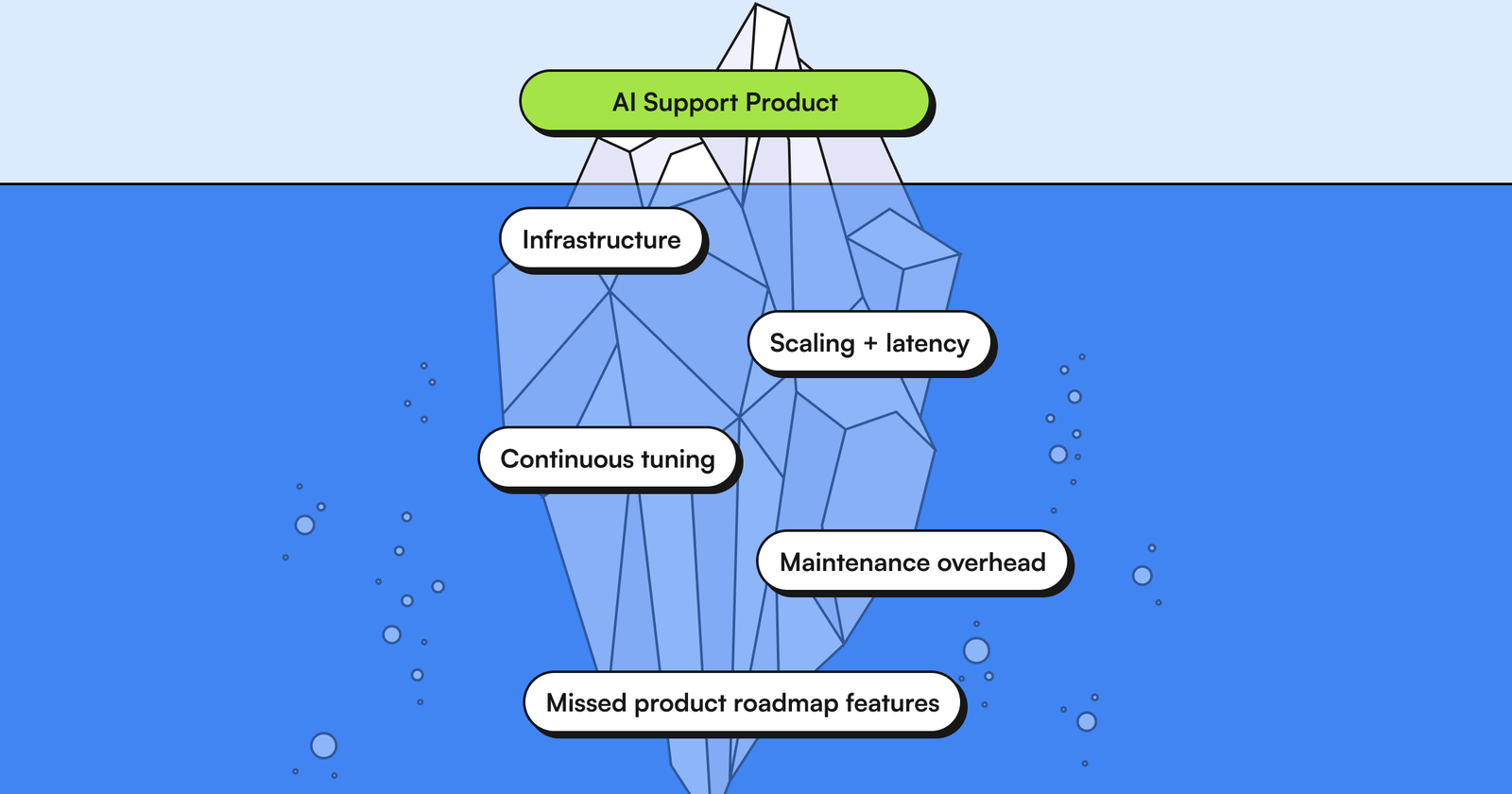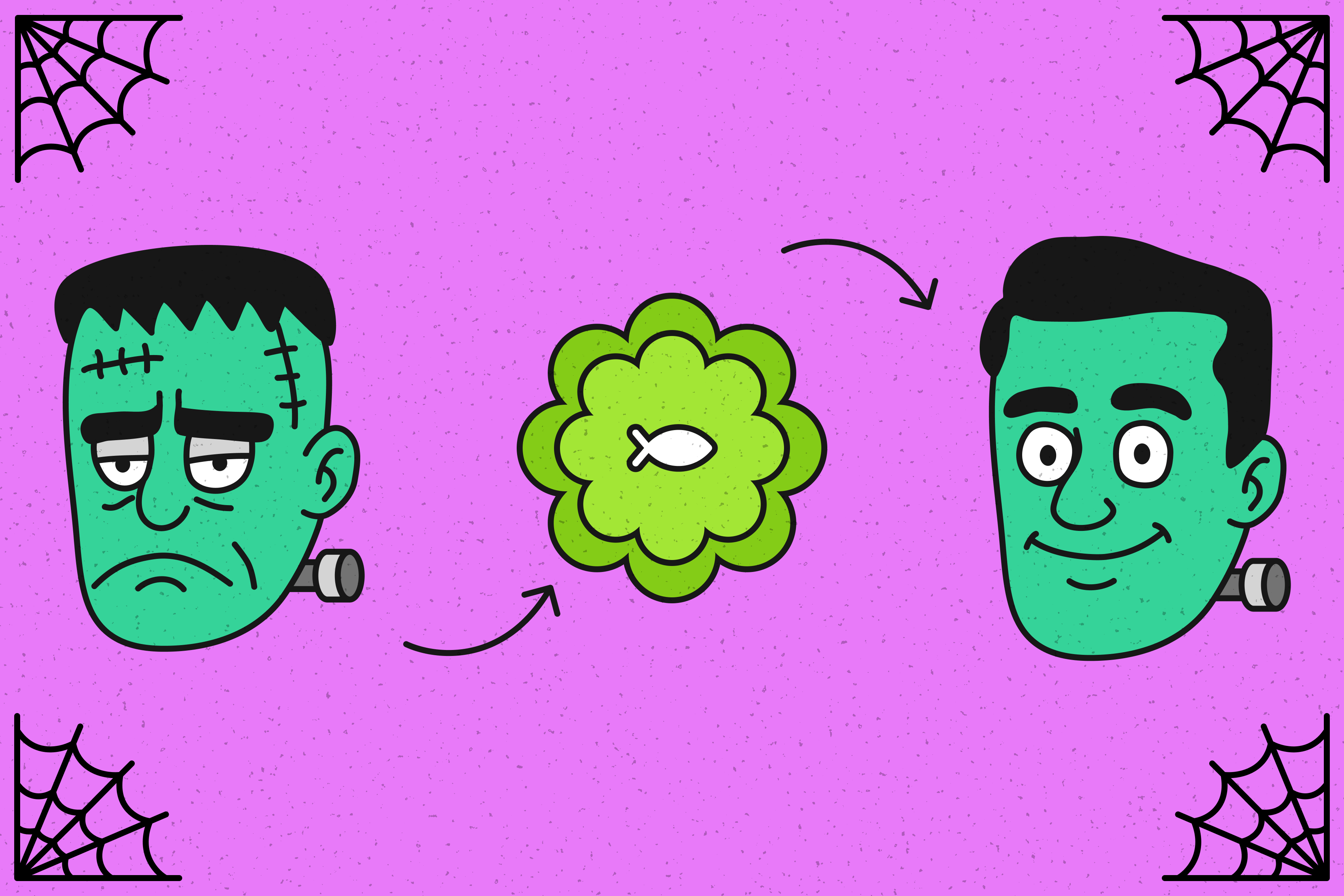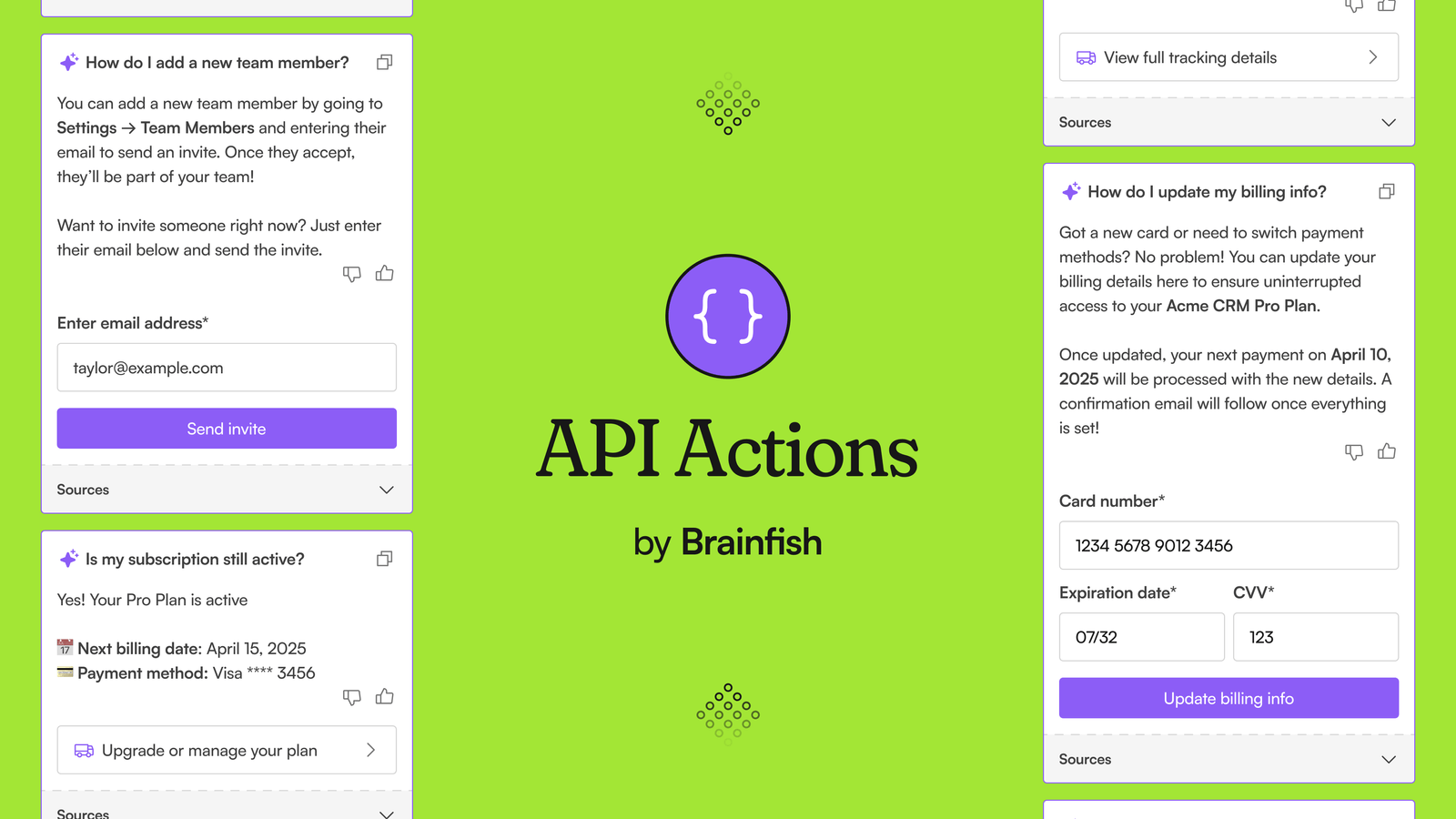The Real Cost of Building vs. Buying AI Support: Why Engineering Teams Underestimate the Challenge
Published on
September 4, 2025























Every day you spend debating build vs. buy, your users are drowning in documentation chaos, your support team is overwhelmed, and your engineering talent is stuck building chatbots instead of features that actually move the revenue needle. The math is ruthless: 90× more expensive to build, 12-24 months longer to deploy, and when you finally launch, you'll discover what one engineering team learned the hard way—"it becomes very challenging to get quality at scale." Meanwhile, companies using ambient AI like Brainfish are achieving 92% self-service rates and watching their NPS scores soar while their engineering teams focus on what they do best: building products that customers actually pay for.
TLDR
Building an AI support solution like Brainfish costs 90× more than buying one. An in-house build typically requires $1.4-1.6M annually vs. $15.6K annually for a subscription solution. Beyond cost, organizations face extended development times (12-24 months), ongoing maintenance burdens, and the opportunity cost of pulling engineering resources from core product development. As one engineering software company learned: "When you try and scale it and actually use it in production, it becomes very challenging to get quality."
The Ambient Intelligence Decision
Think about how modern navigation apps like Google Maps learn from your driving patterns and traffic conditions to provide perfectly timed guidance. They observe collective behavior, analyze contextual data, and deliver assistance exactly when you need it – without being intrusive.
This is what sophisticated AI support systems do for your product experience – they understand context, learn from user behavior, and provide help exactly when needed. But unlike navigation apps, which have massive teams and years of refinement behind them, many companies attempt to build this complex technology in-house, often underestimating the true cost and expertise required.
"These solutions go in and you put up walls to get to a person... nobody thinks about the customer's perspective – they've spent 10 minutes trying to get past this wall of chat bots." - James Pavlovich, Straumann Group
When evaluating whether to build or buy an ambient AI support solution, companies need to look beyond initial development costs and consider the comprehensive resources required. This analysis examines the true expense of building and maintaining an in-house AI support system compared to implementing a ready-made solution like Brainfish.
The Hidden Complexity Behind Simple Experiences
Companies often underestimate what it takes to create truly effective AI support. The simplicity users experience on the surface masks an incredibly sophisticated system underneath that requires specialized skills, extensive infrastructure, and continuous refinement.
As one engineering software company discovered: "When you try and scale it and actually use it in production, it becomes very challenging to get quality." Their experience with an internal RAG-based solution revealed the significant gap between prototype and production-ready AI support.
Core Team Requirements
Building an effective AI support agent requires assembling a diverse team of specialists with highly specific expertise — including AI/ML engineers, data scientists, NLP experts, product managers, and AI trainers. Many of these roles didn’t exist in customer service just a few years ago (Salesforce, 2025), and most companies don’t have them in-house. Even lean teams require expertise that spans data science, DevOps, conversational design, and ethical AI (SmythOS, 2025). The core roles include:
The Price of Expertise
Recruiting and retaining specialists with AI expertise represents a significant investment, particularly in major technology hubs. The table below shows the estimated annual costs for the required team members:
Salaries for AI specialists are highest in tech hubs like Silicon Valley, where an AI/ML engineer averages over $150,000/year before benefits (ZipRecruiter, 2025). When benefits are factored in, the cost for a single engineer can exceed $185,000 annually. Companies competing for top AI talent also face geographic wage inflation, particularly in regions like the Bay Area (Santa Clara University, 2025).
Why Building In-House Takes Longer Than You Think
Developing an AI support system is far more complex than traditional software projects. It follows a multi-stage, iterative lifecycle — from data collection and model design to deployment and refinement (Groove Technology, 2025). While a basic chatbot might be shipped in 3–6 months, production-ready AI support systems often take 12–24 months (Litslink, 2025). Even gathering and cleaning the training data can consume 4–12 weeks alone (SpaceO, 2025). The process involves:
- Planning and Requirement Analysis - Defining the problem scope, establishing goals, and gathering requirements from stakeholders
- Data Collection and Preparation - Often the most time-intensive phase, involving collecting, cleaning, and preprocessing data
- Model Architecture Design and Development - Selecting appropriate AI algorithms and designing the model structure
- Model Training and Testing - Training the model, tuning parameters, and evaluating performance
- Deployment and Integration - Integrating the model into existing infrastructure
- Ongoing Maintenance and Iteration - Continuous monitoring, retraining, and improvement
One major engineering software company, after building a basic RAG-based solution internally, discovered the limitations firsthand. As their product team leader noted: "Right now, we're doing simple RAG-based answers" – but when they tried to scale to production, they faced significant quality challenges. The gap between a functioning prototype and a reliable production system proved much wider than anticipated.
As one CX leader notes: "We chose you (Brainfish) because your analytics and user journey reporting is better than anyone else" - Jenny Eggimann, Head of Customer Success at Clipboard
This extended development timeline means companies face a significant opportunity cost while waiting for their internal solution to become operational and effective.
Beyond Basic RAG: The Quality Gap in Internal Solutions
Many companies attempt to build basic Retrieval-Augmented Generation (RAG) systems internally, as they appear straightforward on the surface. However, there's a significant quality and capability gap between a basic RAG implementation and a comprehensive AI support solution like Brainfish.
As one engineering software product leader observed after building an internal prototype: "When you try and scale it and actually use it in production, it becomes very challenging to get quality."
The Basic RAG Limitations
Internal RAG solutions typically struggle with:
- Limited Knowledge Integration - Difficulty combining content from multiple sources (help documentation, support portals, videos)
- Quality Degradation at Scale - Performance issues when dealing with large volumes of users and content
- Minimal Analytics - Limited or no insight into user behavior and common questions
- Maintenance Burden - Continuous effort required to keep the system updated and performing well
- Format Restrictions - Inability to handle multi-modal content like images and videos
Companies with complex technical products often discover that managing the massive volume of documentation becomes overwhelming. As one product leader mentioned: "We have a lot of technical documentation, videos... just a lot of stuff" and users report "I don't even know where to start."
This documentation complexity creates a perfect storm: users are overwhelmed by volume while internal teams struggle to maintain and organize massive amounts of technical content. Basic RAG solutions simply can't bridge this gap effectively.
Technology and Infrastructure Requirements
Beyond human expertise, building an effective AI support system requires substantial technological infrastructure:
Essential Components
- Cloud Computing Services - AWS, Google Cloud, or Microsoft Azure for processing and hosting
- Machine Learning Platforms - Amazon SageMaker, Google AI Platform, or Azure Machine Learning
- Data Storage Solutions - Cloud-based storage for training and operational data
- AI/ML Development Tools - Frameworks like TensorFlow, PyTorch, and specialized NLP libraries
- NLP Cloud Services - NLP Cloud, Google Cloud Natural Language API, Amazon Comprehend
- Containerization and Orchestration - Docker, Kubernetes for deployment
- Monitoring and Logging Tools - For tracking performance and health
Cloud infrastructure adds to the total cost of ownership. Training and serving models requires services like AWS SageMaker, Azure ML, and Google Cloud, which charge by usage and require high-performance computing (AWS Pricing, 2025; Microsoft Learn, 2025; Trootech, 2025). These ongoing costs often catch teams off guard during scale-up.
Expertise Required to Fill the Knowledge Gap
Teams must also possess a wide array of technical and strategic capabilities — from NLP tuning and model optimization to ethics and UX for AI. These aren't typical skills for traditional dev teams and require significant hiring or retraining (Botpress, 2025; PromptLayer, 2025).
- Programming fundamentals in languages like Python, Java, and C++
- Deep understanding of AI and ML concepts
- Data handling and preprocessing skills
- Natural Language Processing expertise
- Deployment and AI integration capabilities
- Knowledge of search and retrieval systems
- Optimization and efficiency skills
- User Experience design for AI interaction
- AI ethics and security knowledge
- Critical thinking and continuous learning abilities
Acquiring this range of specialized knowledge internally requires significant investment in either training existing staff or hiring new personnel, creating another substantial cost center.
The True Cost of Build vs. Buy Over 3 Years
To understand the full financial implications, let's compare the total cost of ownership for building an AI support agent internally versus subscribing to Brainfish over a three-year period:
Note: Brainfish subscription costs are based on approximately $1,300/month or $15,600 annually.
This comparison demonstrates that the total cost of ownership for building and maintaining an internal AI support agent over three years can be approximately 90 times higher than subscribing to a solution like Brainfish.
Advantages of Buying vs. Building

The decision between building and buying goes beyond direct financial considerations. Choosing a pre-built solution like Brainfish offers several strategic advantages:
1. Faster Time to Value
Buying an AI support solution like Brainfish can reduce time to value from 12–24 months down to just weeks (IrisAgent, 2025).
2. Reduced Development Risk
Internal builds carry major uncertainty around performance, timeline, and user adoption. Even with full commitment, many companies struggle to meet their expectations — a reality acknowledged by others in the space (Intercom, 2025). A proven solution like Brainfish eliminates these risks.
3. Access to Ongoing Updates and Support
After switching to an ambient AI solution, Smokeball saw their self-service rate rise to 92% and NPS jump from 60 to 77 — a significant outcome attributed to intelligent, contextual help.
4. Focus on Core Business Activities
Engineering and product teams can focus on their primary mission – building and improving your core product – rather than creating and maintaining support infrastructure.
5. Scalability and Flexibility
Brainfish is designed to grow with your business and adapt to changing needs without requiring significant additional investment.
6. Multi-Modal Support
Unlike basic internal RAG implementations, Brainfish can handle multiple content types including videos, which as one engineering software company noted: "That's very interesting. I don't think I've seen that before." This advanced capability allows companies to leverage their existing video tutorials and demonstrations as documentation sources.
7. Advanced Analytics
Basic solutions lack the sophisticated analytics that provide crucial product insights. As noted by one product team leader: "The analytics part is also very interesting to me" – recognizing the value in understanding user questions and challenges.
8. Multi-Source Knowledge Integration
Many organizations store documentation across scattered sources – Salesforce, help portals, videos, and training materials. Brainfish seamlessly integrates with all these systems, creating a unified knowledge experience.
Prevention Over Deflection: The Brainfish Approach
Unlike traditional support chatbots that simply aim to deflect tickets, Brainfish's ambient AI agent works quietly in the background of your product, like a smart navigation system that knows when to provide guidance without interrupting your journey.
As one customer experienced: "After implementing an ambient AI approach, Smokeball achieved a 92% self-service rate and saw their support NPS jump from 60 to 77."
For technical products with complex documentation, Brainfish addresses a critical shift in how users learn: "People don't learn sitting in a 5-day training course anymore," as one engineering software leader observed. Modern users need "what I need now, and I'm learning as I go" – precisely the contextual, just-in-time help that Brainfish delivers.
Brainfish combines contextual awareness, real-time learning, pattern recognition, and intelligent understanding to make your product naturally easier to use. Rather than forcing users through rigid flows or making them search for answers, it understands their context and provides help exactly when needed.
The Automated Documentation Advantage
For complex technical products, maintaining accurate and comprehensive documentation is one of the most resource-intensive challenges. As one engineering software company described: "We have a lot of technical documentation, videos... just a lot of stuff" that overwhelms users who report "I don't even know where to start."
Brainfish transforms this documentation burden through:
- Automated Content Generation - Creating documentation automatically based on user interactions and existing content
- Self-Updating Knowledge - Documentation that evolves with product changes without manual intervention
- Multi-Source Integration - Pulling from help files, support portals, training materials, and even videos
- Contextual Delivery - Providing the right information at the right time based on user context
This automated approach dramatically reduces the maintenance burden while ensuring users always have access to the most relevant, up-to-date information exactly when they need it.
Why Brainfish Offers Superior Value
The comprehensive analysis presented in this report demonstrates the significant financial, temporal, and strategic advantages of choosing Brainfish over building an internal AI support solution:
- Cost Efficiency: Brainfish offers comparable capabilities at approximately one-ninetieth the cost of building in-house.
- Faster Implementation: Deploy a sophisticated AI support solution in days rather than the 12-24 months required for internal development.
- Reduced Risk: Eliminate the uncertainty associated with complex AI development projects.
- Focus on Core Business: Keep your engineering and product teams focused on your primary product and revenue-generating activities.
- Continuous Improvement: Benefit from ongoing updates, enhancements, and new features without additional internal effort.
- Beyond Basic RAG: Move past the limitations of simple RAG-based internal solutions to a truly comprehensive support system.
- Multi-Modal Support: Leverage existing videos and visual content as documentation sources.
- Self-Improving Documentation: Never worry about outdated help content again with automatically evolving documentation.
For technical product teams facing the "I don't even know where to start" problem with overwhelming documentation, Brainfish offers a transformative solution that goes far beyond what's possible with internal development.
The question isn't whether your company needs AI-powered support – it's whether building that solution internally represents the best use of your limited resources. For most organizations, the clear answer is to leverage a specialized solution like Brainfish that delivers immediate value while allowing internal teams to focus on what they do best.
Stop building walls between users and help. Your product could be naturally easier to use tomorrow. Add Brainfish to your product today.
import time
import requests
from opentelemetry import trace, metrics
from opentelemetry.sdk.trace import TracerProvider
from opentelemetry.sdk.metrics import MeterProvider
from opentelemetry.sdk.trace.export import ConsoleSpanExporter, SimpleSpanProcessor
from opentelemetry.sdk.metrics.export import ConsoleMetricExporter, PeriodicExportingMetricReader
# --- 1. OpenTelemetry Setup for Observability ---
# Configure exporters to print telemetry data to the console.
# In a production system, these would export to a backend like Prometheus or Jaeger.
trace.set_tracer_provider(TracerProvider())
tracer = trace.get_tracer(__name__)
span_processor = SimpleSpanProcessor(ConsoleSpanExporter())
trace.get_tracer_provider().add_span_processor(span_processor)
metric_reader = PeriodicExportingMetricReader(ConsoleMetricExporter())
metrics.set_meter_provider(MeterProvider(metric_readers=[metric_reader]))
meter = metrics.get_meter(__name__)
# Create custom OpenTelemetry metrics
agent_latency_histogram = meter.create_histogram("agent.latency", unit="ms", description="Agent response time")
agent_invocations_counter = meter.create_counter("agent.invocations", description="Number of times the agent is invoked")
hallucination_rate_gauge = meter.create_gauge("agent.hallucination_rate", unit="percentage", description="Rate of hallucinated responses")
pii_exposure_counter = meter.create_counter("agent.pii_exposure.count", description="Count of responses with PII exposure")
# --- 2. Define the Agent using NeMo Agent Toolkit concepts ---
# The NeMo Agent Toolkit orchestrates agents, tools, and workflows, often via configuration.
# This class simulates an agent that would be managed by the toolkit.
class MultimodalSupportAgent:
def __init__(self, model_endpoint):
self.model_endpoint = model_endpoint
# The toolkit would route incoming requests to this method.
def process_query(self, query, context_data):
# Start an OpenTelemetry span to trace this specific execution.
with tracer.start_as_current_span("agent.process_query") as span:
start_time = time.time()
span.set_attribute("query.text", query)
span.set_attribute("context.data_types", [type(d).__name__ for d in context_data])
# In a real scenario, this would involve complex logic and tool calls.
print(f"\nAgent processing query: '{query}'...")
time.sleep(0.5) # Simulate work (e.g., tool calls, model inference)
agent_response = f"Generated answer for '{query}' based on provided context."
latency = (time.time() - start_time) * 1000
# Record metrics
agent_latency_histogram.record(latency)
agent_invocations_counter.add(1)
span.set_attribute("agent.response", agent_response)
span.set_attribute("agent.latency_ms", latency)
return {"response": agent_response, "latency_ms": latency}
# --- 3. Define the Evaluation Logic using NeMo Evaluator ---
# This function simulates calling the NeMo Evaluator microservice API.
def run_nemo_evaluation(agent_response, ground_truth_data):
with tracer.start_as_current_span("evaluator.run") as span:
print("Submitting response to NeMo Evaluator...")
# In a real system, you would make an HTTP request to the NeMo Evaluator service.
# eval_endpoint = "http://nemo-evaluator-service/v1/evaluate"
# payload = {"response": agent_response, "ground_truth": ground_truth_data}
# response = requests.post(eval_endpoint, json=payload)
# evaluation_results = response.json()
# Mocking the evaluator's response for this example.
time.sleep(0.2) # Simulate network and evaluation latency
mock_results = {
"answer_accuracy": 0.95,
"hallucination_rate": 0.05,
"pii_exposure": False,
"toxicity_score": 0.01,
"latency": 25.5
}
span.set_attribute("eval.results", str(mock_results))
print(f"Evaluation complete: {mock_results}")
return mock_results
# --- 4. The Main Agent Evaluation Loop ---
def agent_evaluation_loop(agent, query, context, ground_truth):
with tracer.start_as_current_span("agent_evaluation_loop") as parent_span:
# Step 1: Agent processes the query
output = agent.process_query(query, context)
# Step 2: Response is evaluated by NeMo Evaluator
eval_metrics = run_nemo_evaluation(output["response"], ground_truth)
# Step 3: Log evaluation results using OpenTelemetry metrics
hallucination_rate_gauge.set(eval_metrics.get("hallucination_rate", 0.0))
if eval_metrics.get("pii_exposure", False):
pii_exposure_counter.add(1)
# Add evaluation metrics as events to the parent span for rich, contextual traces.
parent_span.add_event("EvaluationComplete", attributes=eval_metrics)
# Step 4: (Optional) Trigger retraining or alerts based on metrics
if eval_metrics["answer_accuracy"] < 0.8:
print("[ALERT] Accuracy has dropped below threshold! Triggering retraining workflow.")
parent_span.set_status(trace.Status(trace.StatusCode.ERROR, "Low Accuracy Detected"))
# --- Run the Example ---
if __name__ == "__main__":
support_agent = MultimodalSupportAgent(model_endpoint="http://model-server/invoke")
# Simulate an incoming user request with multimodal context
user_query = "What is the status of my recent order?"
context_documents = ["order_invoice.pdf", "customer_history.csv"]
ground_truth = {"expected_answer": "Your order #1234 has shipped."}
# Execute the loop
agent_evaluation_loop(support_agent, user_query, context_documents, ground_truth)
# In a real application, the metric reader would run in the background.
# We call it explicitly here to see the output.
metric_reader.collect()Recent Posts...
You'll receive the latest insights from the Brainfish blog every other week if you join the Brainfish blog.











